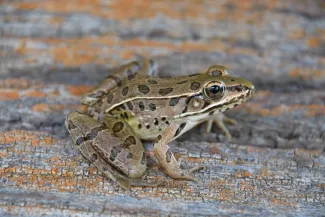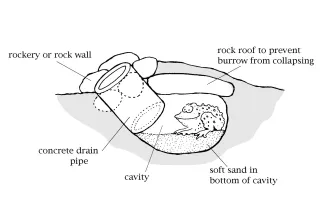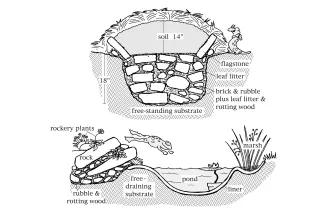Many people often overlook amphibians and reptiles in their wildscapes, even though they occasionally see snakes, lizards, frogs, salamanders, and turtles. These animals provide many beneficial actions: almost all reptiles and amphibians eat pest species such as insects and rodents; frogs and toads help to loosen up soil in our gardens; and all of these species serve as prey for other wildlife. If you find reptiles and amphibians in your urban wildscape, encourage them to stay, but do not keep them as pets.

Most amphibians and reptiles have different food and water requirements at varying stages of their life cycles. For example, all amphibians (salamanders, toads, and frogs) hatch in water, but most live on land after metamorphosing from tadpoles. Red-eared sliders are carnivorous during earlier stages of life but gradually switch to a vegetarian diet.
Certainly, having a source of fresh water will improve the chances of attracting amphibians to your wildscape. Even a small 3 x 3-foot pond would provide enough water for tadpoles to develop. Such a breeding pond would serve as a reliable source for frogs or toads to return to each spring. A larger pond would attract water turtles, including red-eared sliders and softshell turtles. Some water snakes may also make a larger pond their home. However, if you want to help frogs, you should not put minnows or goldfish in the pond – they eat frog eggs. Mosquitofish would be acceptable and would help control the mosquitoes that would otherwise develop in standing water.
More Tips for Establishing Wildscape Water Sources
Insects are the mainstay of many reptiles’ diets, as are small rodents. If you notice more snakes in your yard, it could be because they are preying on these pests. By leaving these harmless animals in your yard, you will provide natural pest control.
- Managing Amphibians and Reptiles in Urban Wildscapes
Reptiles and amphibians are small and secretive, usually hiding and finding their food in heavy cover. Although you may not even see these species, you can improve habitat in your yard for them when you:
- Provide toad holes and toad lights. Dig a hole several inches deep and line it with peat or compost. Cover it with a flat rock or board and scoop out an entrance into the cavity. By placing a low voltage light a few feet above the ground near the toad hole, you will attract insects closer to where the toads are hiding.
Image
- Encourage native ground cover, grasses, and wildflowers. A finely trimmed lawn is not very attractive to reptiles, amphibians, or other wildlife.
- Leave stumps, rotting logs, and stones where possible. Leaf litter left under trees and shrubs and in gardens can also serve to produce reptile and amphibian homes by decomposing and providing loose, moist soil.
- Provide breeding ponds for amphibians or turtles. Do not try to introduce adult amphibians and reptiles into your wildscape. Instead wait for adults to make your wildscape their home.
- Provide brush, wood, and rock piles as valuable shelter and basking sites for amphibians and reptiles. Build rock walls with plenty of cracks and crevices.
- Discourage cats from using your yard. These efficient hunters frequently wipe out populations of amphibians, reptiles, and small mammals.
- Provide perches, such as wooden rail or slat fences, for lizards to bask, catch insects, and set up territories.
- Managing Ponds for Amphibians and Reptiles
Owners of rural wildscapes know that ponds are vital to many reptiles and amphibians as well as to other wildlife species. Although shallow ponds may not support fish because they dry up in the heat of summer, they do provide valuable water holes for amphibians and reptiles in spring. Ponds with a wide variety of wildlife and plants also provide aesthetic values to the owner.
Many people mistakenly assume that turtles and snakes eat large numbers of fish, depleting the stock in a pond or river. However, these species actually enhance fishing opportunities by eating dead or diseased fish. This allows the remaining fish to prosper.
Ponds are fairly simple to manage for reptiles and amphibians – just let nature take its course after the plants and wildlife are established. However you can still do several things to enhance your pond for amphibians and reptiles:
- Fence the pond and a portion of its watershed to keep livestock out of the water. You can place a stock tank below the dam and outside the fence to provide water for livestock. This ensures a cleaner water source free from the bacteria and ammonia in livestock droppings.
- Do not plow or allow grazing in the immediate vicinity of the pond. This will improve water quality in the pond and will leave ground cover that can be used as wildlife corridors to other habitats.
- For aquatic turtles, anchor several logs in open water away from the bank to serve as basking sites. Red cedar logs are ideal for this purpose.
- Log piles, rock piles, and brush piles around the pond’s edge provide valuable basking sites and cover.
- Managing Woodlands for Amphibians and Reptiles
Many of the actions that constitute a normal part of managing a forested or prairie area can have spin-off benefits for wildlife.
- Excluding livestock grazing to allow the growth of nonwoody plants that provide additional cover sources for ground-dwelling amphibians and reptiles.
- Leaving several snags standing per acre for lizards and black rat snakes to use for shelter; skinks also lay their eggs in snags.
- Leaving natural shelters such as stumps, fallen logs, and brush piles on the forest floor to provide cover and shelter sources. Red-backed and slimy salamanders burrow under logs on forested slopes. Ground skinks, fence lizards, and small forest snakes such as brown snakes, redbelly snakes, earth snakes, and red milksnakes also benefit from additional cover sources.
- Planting fruiting shrubs and trees, such as pokeweed, sand plum, mulberry, and raspberry, in the understory to attract box turtles.
- Leaving thick undergrowth as cover sources for frogs like spring peepers and gray treefrogs. This undergrowth attracts the insects that reptiles and amphibians eat.
- Building ponds in and near the edge of woodlands for species such as spotted and tiger salamanders to lay their eggs. Other species, such as the central newt, live in woodland ponds as adults.
- Managing Prairies for Amphibians and Reptiles
By managing fields and prairies for a variety of native grasses and other plants, you’ll encourage additional insects and rodents, which in turn will attract amphibians and reptiles that prey on these pest species.
To manage your prairie, consider the following:
- For old fields that have been extensively grazed or plowed, reseed with native grasses and wildflowers. The seed bank – native seeds found naturally in the area but that have had their growth suppressed by human actions – may still exist and may help bring back these plant species.
- Consider applying prescribed fire to all or portions of your prairie to keep invasive species at bay. Provide rock piles for shelter along fence rows, near the edges of woodlots, and on south-facing slopes of hillsides.
- Leave or construct shallow ponds and marshes (3-5 inches deep) in your prairie. You may wish to protect these water sources from livestock by fencing around them.
- Building an Amphibian Hibernaculum
Although ponds and streams provide summer breeding habitats for frogs, toads, and salamanders, you can provide for their needs year-round by creating a place where amphibians can hibernate in the winter. Hibernacula are especially important in urbanized areas where natural habitats have been destroyed or severely degraded. You can build an amphibian hibernaculum on a well-drained site, a poorly drained site, or even merged into the plan for your garden pond.
Image
Materials Needed
- Shovel
- Bricks (broken and unbroken)
- Wood and lumber scraps
- Leaf litter
- Flagstone or concrete slabs
- Straw
- Rocks (optional)
Directions
- Dig a hole 18 inches deep, so that the total area is a minimum of two square yards.
- Fill the opening with whole and half brick rubble, creating plenty of spaces among the bricks. Mix in bits of wood and leaf litter to provide sources of humidity.
- Place flagstone, concrete slabs, or other flat, heavy material so that it covers the edge of the bricks. Make sure entry gaps lead under the flagstone.
- Cover the entire area with soil, making sure the entry gaps remain clear.
- Top the mound with straw.
- For a garden pond hibernaculum, place rocks around the edge. You can include rock garden plants as long as the entry gaps remain open. Trees and garden plantings near the pond provide important habitat for reptiles and amphibians during the terrestrial part of their life cycle.
This content originally appeared in the Wildlife Department’s “Landscaping for Wildlife” guide. The full guide can be viewed here.